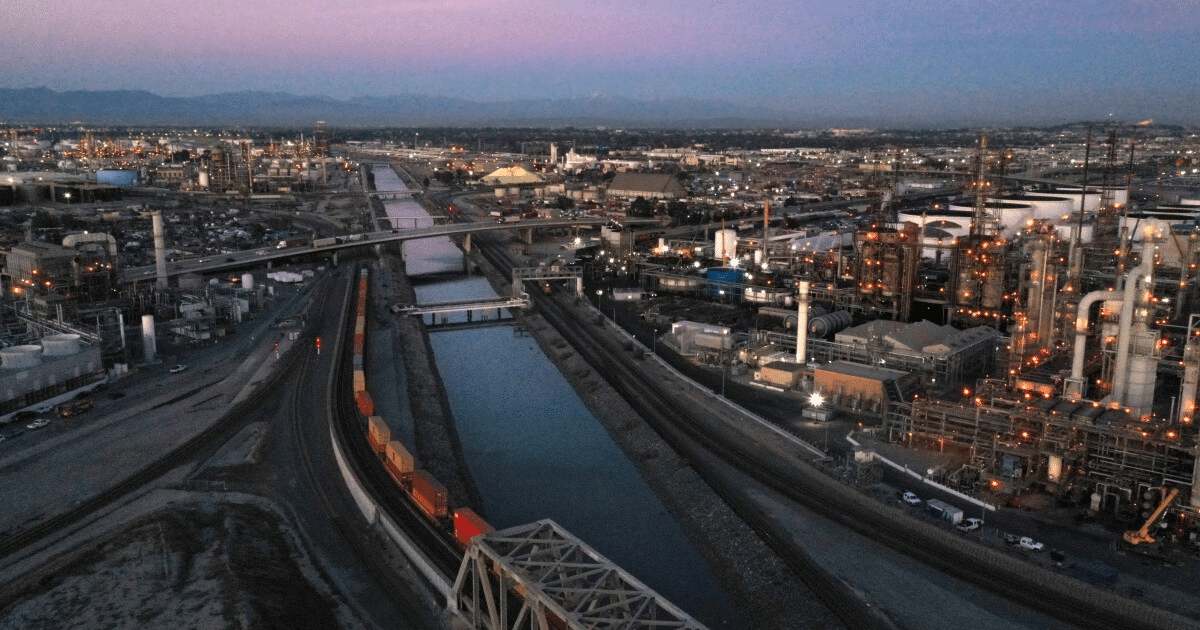Another question our team is frequently asked is about Prop 65 and its associated product labeling. Most people outside of California and possibly even a few Californians themselves don’t know about Proposition 65, officially known as the Safe Drinking Water and Toxic Enforcement Act of 1986, which was enacted in the state of California as of November 1986. As indicated by the name, this law started out with very good intentions, and it has evolved to cover more applications than originally envisioned, including some impact on the automotive lubricants industry.

Background
In 1968, when a chemical leak into the Dominguez Channel (Los Angeles) resulted in a $100 fine for the company responsible, the Los Angeles Times said that the state was “in serious danger of losing the fight against pollution of its irreplaceable water resources.”

Pictured: Dominguez Channel, courtesy Dairys Farm Residences
A few years later it was discovered in some California counties the land was heavily contaminated with nitrates that could leach into drinking water supplies. In 1984, state officials found solvents from electronic products had contaminated the groundwater in Silicon Valley. A 1986 LA Times poll found around 40% of Californians avoided tap water out of health concerns. The EPA approach to the issue was more of a “innocent until proven guilty approach” and was not proactive enough for California lawmakers.
Environmental watchdogs had been fighting for years to provide accountability and transparency for hazardous materials but efforts had been pushed back by industry lobbyists. Legislation was introduced known as Proposition (Prop) 65, which would require manufacturers to include a label warning consumers of chemicals known to the state to cause cancer or reproductive toxicity in their products. The Safe Drinking Water and Toxic Enforcement Act was passed by voters as a ballot initiative in a 63% to 37% margin.
Current applications
The intent of Prop 65 was to encourage manufacturers to reformulate their products to non-toxic formulations. It was also intended to eliminate toxins in the water supply by holding corporations liable for improper disposal of chemicals. The now-familiar warning label on products states, “This product may contain chemicals known to the State of California to cause cancer, birth defects, or other reproductive harm.” This labeling can be found on many different types of products from clothing to jewelry.
Initially there were 178 chemicals linked to cancer or birth defects that required labeling as such or companies risked $2500/day in fines. Outside of industrial applications, the law led to reformulations of many consumer products including water filters, baby powders, and hair dyes which, because of California’s market size, benefited people across the US as it was easier and more cost-effective to adjust formulations for all states. Today there are nearly 1,000 chemicals with links to health hazards on the Prop 65 list.
Lead reduction
Private lawsuits brought against manufacturers were eventually successful in bringing about reduction of lead levels in some products. Lead is one particularly toxic contaminant which has been shown to cause a wide array of health problems including high blood pressure, heart disease, kidney disease, fertility issues, and mental health illness.1
One of the results of this litigation was the Prop 65 label warning on all affected products in order to avoid litigation. Out of concern consumers were ignoring the labels, a new statute requires a manufacturer to include the name of the chemical(s) on the label in hopes of increasing awareness and decreasing unnecessary labeling.

Results and insight
Unfortunately, Prop 65 has not significantly reduced the levels of contaminated drinking water in rural areas, the epicenter of initial concern. However, it has provided more accountability and consumer awareness of what known harmful ingredients are contained in our products, and has resulted in a decrease of many harmful chemicals, such as previously mentioned regarding lead.

ENEOS and Prop 65
ENEOS has always sought to make improvements that result in ecological and environmental benefits, whether seeking new energy developments, such as ENEOS’ partnership with Toyota’s hydrogen-powered Woven City, or supporting electrical vehicles technology with our upcoming line of EV products. We also have worked in conjunction with OEMs for over a decade on lower viscosity oils to help increase fuel economy.
This mission includes not using harmful chemicals in our products whenever possible. For this reason, our products do not require the Prop 65 label.2 To check whether an automotive fluid carries (or should carry) the warning, check its Safety Data Sheet (SDS), which can typically be found online.<
[1] According to Centers for Disease Control (CDC)
[2] With the exception of ENEOS RACING Pro 10W-50 (due to required ingredients for its optimal function) and Import ATF Model H (due to a supplier oversight of one impacted ingredient at very low levels that is in process of being transitioned out)
